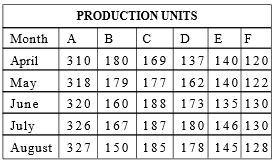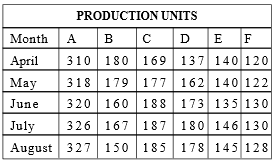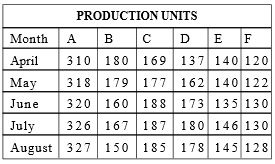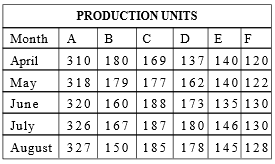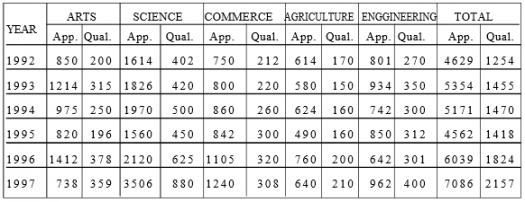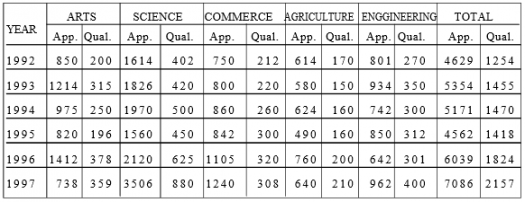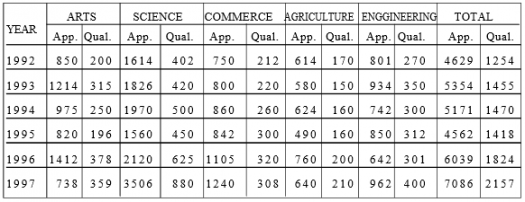Data Interpretation Basics Tabular
(179).webp)
Explore the basics of data interpretation through a series of questions focused on analyzing sugar production data across various units in India. This quiz assesses the ability to read tables, calculate percentages, and identify trends.
- 1.
Production of sugar by six major production units of India in Million Tonnes is given in the table. In which month the unit B has a contribution of approximately 15% in the total sugar production?
- A.
August
- B.
June
- C.
July
- D.
April
Correct Answer
C. July -
- 2.
Production of sugar by six major production units of India in Million Tonnes is given in the table. Which of the following units shows continuous increase in production of sugar over months?
- A.
A
- B.
B
- C.
C
- D.
D
Correct Answer
A. AExplanation
Unit A shows continuous increase in production of sugar over months.Rate this question:
-
- 3.
Production of sugar by six major production units of India in Million Tonnes is given in the table. In the case of Unit E, in which of the following pairs of months the production of sugar was equal?
- A.
April & June
- B.
June & July
- C.
July & August
- D.
April & May
Correct Answer
D. April & MayExplanation
The table provided shows the production of sugar by six major production units in India. To determine in which pair of months the production of sugar was equal for Unit E, we need to look at the corresponding values for Unit E in the table. The production of sugar for Unit E in April is given, and the production in May is also given. Since the question asks for the pair of months where the production was equal, we can conclude that the production of sugar was equal in April and May for Unit E.Rate this question:
-
- 4.
Production of sugar by six major production units of India in Million Tonnes is given in the table. In the month of June, how many units have a share of more than 25% of the total production of sugar?
- A.
1
- B.
3
- C.
2
- D.
4
Correct Answer
A. 1Explanation
In the given table, the production of sugar by six major production units in India is provided. To determine the number of units with a share of more than 25% of the total production of sugar in the month of June, we need to compare the production of each unit with 25% of the total production. Since the answer is 1, it means that only one unit has a production share greater than 25% of the total production.Rate this question:
-
- 5.
Production of sugar by six major production units of India in Million Tonnes is given in the table. What was approximate percentage decrease in sugar production of unit B in June as compared to April?
- A.
8%
- B.
10%
- C.
15%
- D.
18%
Correct Answer
B. 10%Explanation
The approximate percentage decrease in sugar production of unit B in June compared to April is 10%.Rate this question:
-
- 6.
NUMBER OF CANDIDATES APPEARED AND QUALIFIED UNDER VARIOUS DISCIPLINES IN AN EXAMINATION OVER THE YEARS is provided in the following table. In which of the following disciplines was there a continuous increase in the number of candidates appeared over the given years?
- A.
Agriculture
- B.
Arts
- C.
Science
- D.
None
Correct Answer
D. NoneExplanation
The question asks which discipline had a continuous increase in the number of candidates appeared over the years. However, the answer is "None," indicating that none of the disciplines had a continuous increase in the number of candidates appeared.Rate this question:
-
- 7.
NUMBER OF CANDIDATES APPEARED AND QUALIFIED UNDER VARIOUS DISCIPLINES IN AN EXAMINATION OVER THE YEARS is provided in the following table. What was the percentage drop in number of candidates qualified in Science discipline from 1994 to 1995?
- A.
10
- B.
20
- C.
25
- D.
50
Correct Answer
A. 10Explanation
The percentage drop in the number of candidates qualified in the Science discipline from 1994 to 1995 is 10%.Rate this question:
-
- 8.
NUMBER OF CANDIDATES APPEARED AND QUALIFIED UNDER VARIOUS DISCIPLINES IN AN EXAMINATION OVER THE YEARS is provided in the following table. The number of candidates appeared under Agriculture in 1995 was approximately what percentage of number of candidates qualified under Arts in 1994?
- A.
400
- B.
200
- C.
100
- D.
20
Correct Answer
B. 200Explanation
The number of candidates appeared under Agriculture in 1995 was approximately half of the number of candidates qualified under Arts in 1994. This can be calculated by dividing the number of candidates appeared under Agriculture in 1995 (400) by the number of candidates qualified under Arts in 1994 (200). The result is 2, which can be expressed as 200% when converted to a percentage. Therefore, the number of candidates appeared under Agriculture in 1995 was approximately 200% of the number of candidates qualified under Arts in 1994.Rate this question:
-
- 9.
NUMBER OF CANDIDATES APPEARED AND QUALIFIED UNDER VARIOUS DISCIPLINES IN AN EXAMINATION OVER THE YEARS is provided in the following table. In which of the following years was the percentage of total number of candidates of all the disciplines together qualified to the appeared ones, the maximum?
- A.
1993
- B.
1994
- C.
1995
- D.
1996
Correct Answer
C. 1995Explanation
The percentage of total number of candidates of all the disciplines together qualified to the appeared ones was the maximum in the year 1995.Rate this question:
-
- 10.
NUMBER OF CANDIDATES APPEARED AND QUALIFIED UNDER VARIOUS DISCIPLINES IN AN EXAMINATION OVER THE YEARS is provided in the following table. In which of the following years was the percentage of qualified to the appeared ones in engineering discipline the maximum?
- A.
1994
- B.
1995
- C.
1997
- D.
1996
Correct Answer
D. 1996Explanation
The explanation for the given correct answer is that in 1996, the percentage of qualified candidates in the engineering discipline was the highest compared to the other years mentioned. This means that a larger proportion of the candidates who appeared for the examination in the engineering discipline in 1996 were able to qualify.Rate this question:
-
- 11.
BSNL announced a cut in STD rates on 27.12.2001. The new rates and slabs are given in the table below and are to be implemented from 14.01.2002. Assume you are given this question on 01.01.2002. The maximum percentage reduction in costs will be experienced for calls over which of the following distance (in km)?
- A.
50-200
- B.
200-500
- C.
500-1000
- D.
>1000
Correct Answer
B. 200-500Explanation
The maximum percentage reduction in costs will be experienced for calls over the 200-500 km distance range. This is because the new rates and slabs announced by BSNL will be implemented from 14.01.2002, and the maximum reduction in costs will likely be applied to the longer distance calls within this range. Calls within the 50-200 km range may also see a reduction, but it is likely to be lower than the reduction for the 200-500 km range. The rates for calls over 500 km and greater than 1000 km may not experience as significant a reduction in costs compared to the 200-500 km range.Rate this question:
-
- 12.
BSNL announced a cut in STD rates on 27.12.2001. The new rates and slabs are given in the table below and are to be implemented from 14.01.2002. Assume you are given this question on 01.01.2002. The percentage difference in the cost of a set of telephone calls made on the 13th and 14th January having durations of 4 minutes over a distance of 350 km, 3 minutes for a distance of 700 km, and 3 minutes for a distance of 1050 km is (if all the three calls are made in peak times)
- A.
51.2%
- B.
51.75%
- C.
59.8%
- D.
Can't say
Correct Answer
B. 51.75%Explanation
The given answer, 51.75%, is the percentage difference in the cost of the telephone calls made on the 13th and 14th January. The question states that BSNL announced a cut in STD rates on 27.12.2001 and the new rates and slabs are to be implemented from 14.01.2002. Therefore, the cost of the telephone calls made on the 14th January would be lower than the cost of the calls made on the 13th January. The specific calculations to arrive at the percentage difference are not provided, but based on the given information, the correct answer is 51.75%.Rate this question:
-
- 13.
BSNL announced a cut in STD rates on 27.12.2001. The new rates and slabs are given in the table below and are to be implemented from 14.01.2002. Assume you are given this question on 01.01.2002. If one of the three calls in Q. 12 were made in an off-peak time on both days, then the percentage reduction in the total cost of the calls between 13th and 14th January will
- A.
Definitely reduce
- B.
Definitely increase
- C.
Depend on which particular call was made in off peak time
- D.
Can't be determined
Correct Answer
A. Definitely reduceExplanation
The given question states that BSNL announced a cut in STD rates on 27.12.2001, and these new rates are to be implemented from 14.01.2002. The question also mentions that one of the three calls in Q. 12 were made in an off-peak time on both days. Since the off-peak time has lower rates, it is clear that the total cost of the calls between 13th and 14th January will definitely reduce.Rate this question:
-
- 14.
BSNL announced a cut in STD rates on 27.12.2001. The new rates and slabs are given in the table below and are to be implemented from 14.01.2002. Assume you are given this question on 01.01.2002. A person talks for a certain no. of minutes at peak rates and off peak rates on 13.01.2002 for 50- 200 km distance such that his average cost of talking per minute is Rs 3.7/minute. Find the least time that he talked (assuming he talks only in multiples of a minute).
- A.
27 min
- B.
43 min
- C.
36 min
- D.
Can't say
Correct Answer
C. 36 min -
- 15.
Expected market of four brands of automobiles in the four metros (In terms of percentage of number of units sold) is shown. What will be the average percentage increase in the market share of Opel Astra in the metros?
- A.
25%
- B.
9.5%
- C.
16%
- D.
5.5%
Correct Answer
C. 16%Explanation
The average percentage increase in the market share of Opel Astra in the metros can be calculated by finding the average of the given percentages. The percentages given are 25%, 9.5%, 16%, and 5.5%. Adding these percentages and dividing by 4 gives an average of 14.25%. However, since the question asks for the average percentage increase, we need to subtract the initial market share of Opel Astra from this average. As the initial market share is not given, we cannot determine the exact average percentage increase. Therefore, the given answer of 16% cannot be confirmed or refuted based on the information provided.Rate this question:
-
- 16.
Expected market of four brands of automobiles in the four metros (In terms of percentage of number of units sold) is shown. PAL-Peugeot’s sales in the four metros have been
- always more than those of Opel Astra.
- always maximum in Calcutta.
- A.
1 only
- B.
1 and 2 only
- C.
1,2,3
- D.
2 only
Correct Answer
D. 2 onlyExplanation
The given answer states that PAL-Peugeot's sales in the four metros have always been maximum in Calcutta. This means that out of the four metros, Calcutta has consistently had the highest sales for PAL-Peugeot compared to the other three metros. However, the answer does not mention anything about PAL-Peugeot's sales being always more than those of Opel Astra or always increasing. Therefore, the correct answer is 2 only.Rate this question:
- 17.
Expected market of four brands of automobiles in the four metros (In terms of percentage of number of units sold) is shown. If the combined sales of all four is expected to go from 11000 to 12500 in Mumbai between 1996 and 1997 the increase in Mercedes-Benz’s revenues will show a per cent growth, if the price were to go up by 12% in 1997.
- A.
10%
- B.
50%
- C.
75%
- D.
100%
Correct Answer
D. 100%Explanation
The increase in Mercedes-Benz's revenues will show a 100% growth if the price were to go up by 12% in 1997. This can be calculated by finding the percentage increase in revenue when the price increases by 12%. Since the price increase is given as a percentage, we can directly use it to calculate the percentage increase in revenue. Therefore, a 12% increase in price will result in a 12% increase in revenue.Rate this question:
-
- 18.
Expected market of four brands of automobiles in the four metros (In terms of percentage of number of units sold) is shown. Given that the cost of a PAL-Peugeot and a DCM-Daewoo is same, an Opel Astra costs twice as much as a PAL-Peugeot, and a Mercedes-Benz is twice as costly as a PAL-Peugeot, the net revenue from the four metros was maximum for
- A.
PAL-Peugeot and DCM-Daewoo
- B.
Opel Astra
- C.
Mercedes-Benz
- D.
Can't say
Correct Answer
D. Can't sayExplanation
The question provides information about the relative costs of the different automobile brands, but it does not provide any information about the market demand or sales of each brand in the four metros. Without information about the market demand or sales, it is not possible to determine which brand would generate the maximum net revenue. Therefore, the correct answer is "Can't say."Rate this question:
-
- 19.
Expected market of four brands of automobiles in the four metros (In terms of percentage of number of units sold) is shown. If in 1996 sales were 11000, 10000, 9000 and 8000 respectively in the four metros, then the following are almost equal:
- A.
PAL-Peugeot sales in Mumbai and Calcutta
- B.
DCM-Daewoo sales in Delhi and Madras
- C.
Opel-Astra sales in Mumbai and Madras
- D.
Mercedes-Benz sales in Delhi and Calcutta
Correct Answer
B. DCM-Daewoo sales in Delhi and MadrasExplanation
The given answer suggests that the sales of DCM-Daewoo in Delhi and Madras are almost equal. This can be inferred from the information provided about the expected market of four brands of automobiles in the four metros. Since the question states that the sales of the four brands in 1996 were given, we can assume that the expected market is based on these sales figures. Therefore, if the expected market indicates that the sales of DCM-Daewoo in Delhi and Madras are almost equal, it means that the sales figures for these two cities are similar or very close to each other.Rate this question:
-
- 20.
Expected market of four brands of automobiles in the four metros (In terms of percentage of number of units sold) is shown. The combined share of Opel Astra in Mumbai and Madras is 22%. The sales volume of Opel Astra in Mumbai is how many times that in Madras?
- A.
7/3
- B.
5/4
- C.
8/5
- D.
None of these
Correct Answer
A. 7/3Explanation
The combined share of Opel Astra in Mumbai and Madras is 22%. Let's assume the sales volume of Opel Astra in Mumbai is x units. Therefore, the sales volume of Opel Astra in Madras would be (22 - x) units. We need to find the ratio of the sales volume in Mumbai to that in Madras, which is x / (22 - x). Simplifying this ratio, we get 7/3. Hence, the sales volume of Opel Astra in Mumbai is 7/3 times that in Madras.Rate this question:
-
Quiz Review Timeline +
Our quizzes are rigorously reviewed, monitored and continuously updated by our expert board to maintain accuracy, relevance, and timeliness.
-
Current Version
-
Jan 04, 2024Quiz Edited by
ProProfs Editorial Team -
Jul 31, 2020Quiz Created by
Surekavarun5



